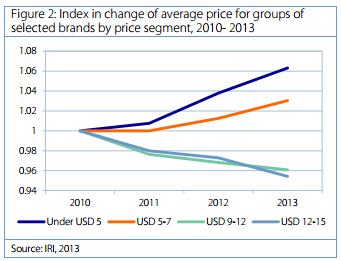So says Rabobank in its Q4 2014 Wine Quarterly, where analysts Stephen Rannekleiv, Marc Soccio and Elena Saputo state that wineries with more sophisticated price management tools are seeing direct benefits to their bottom line.
“Given the increasing role of chains in the US wine market, successful management of prices is becoming a critical skill for those seeking to penetrate this channel,” they write.
Developing these skills is complex, due to the variety of SKUs, varying costs, regulations and mark-up structures in different states, but Rannekleiv et al. believe that investments to improve these capabilities can deliver long-term dividends to wine marketers, particularly those selling through chain accounts.

US wine market sales volumes have improved in recent years, as has the average bottle price of wine sold – with high-end products gaining share at the expense of lower-priced offerings.
In 2010 the average price/unit sold of wine sold in US off-premise channels was $7.62; in 2013 it was $8.23 – strong growth in the $9-15 bottle range drove the average up while sub-$9 bottle sales declined.
However, Rabobank notes the sub-$9 volume decline is, in part at least, due to rising prices for consumers as grape costs increase.
Meanwhile, in the $9-15 category, sales have been spurred by innovation – Nielsen estimates that 44% of new launches in the off-premise wine category in the past two years came in this price segment.
Another factor driving $9-15 growth is pricing pressure on major brands in ‘higher priced segments’ that have suffered consistent year-on-year price declines – as the IRI data shows on Rabobank’s infographic.
Luxury US wines – particularly those from Napa and Sonomo going direct to consumer (DTC) – have been able to raise prices due to scarce supply and a consumer relationship that cuts out wholesalers, Rabobank’s analysts state, noting that many small wineries are finding DTC a profitable sales channel to cultivate.
But this isn’t a solution for everyone, and Rabobank notes that mainstream US wine brand pricing is under particular pressure as the retail environment evolves, with chain accounts rather than independents generating most of the growth in this market.
Brands cannot ignore chain accounts such as grocery stores if they wish to achieve scale, Rabobank states, but the fight for shelf space here brings margin pressure (as does the rise of discount chains) that they need to be offset by via higher sales volumes/velocity.
“Most brand owners understand this, but the challenge often stems from the complexity of measuring how changes to the FOB price will impact the final retail shelf price for each state (or market) after different taxes, freight costs, wholesaler and retailer mark-ups are added in,” Rannekleiv et al. write.
To manage pricing relative to their competitors, Rabobank says some wineries are working on in-house price management systems, while others are turning to external software and services.
The goal is to gain visibility on price elasticity – sales volumes changes stemming from price changes – which varies dramatically according to brand, varietal, seasonality, competitor price moves, etc.
While discounting can improve sales volumes, Rannekleiv and his colleagues warn that it must be managed with “extreme caution…pervasive discounting can erode a brand’s image, particularly if prices drop below certain key price thresholds – even temporarily”.
“Common wisdom in the wine industry suggests that pricing tends to go in one direction – once it starts declining, it can be difficult to recover,” they write.
“The US wine market is littered with once profitable brands that were seduced by the short-term benefits of discounting and degraded their brand equity,” the analysts add.
